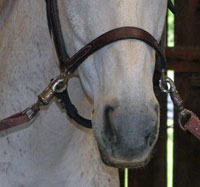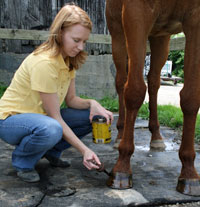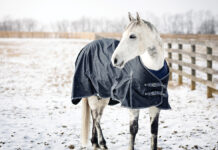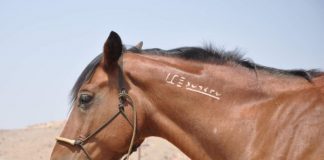
If you enjoy riding and equestrian activities, it is important to learn and follow safe horse handling procedures. Even experienced horse people need to remember to be vigilant about maintaining safe habits. Because grooming is part of our regular routine with our horses, it’s easy to become complacent and get careless about safety as we go about the task. Here are some important things to keep in mind.
Safe Tying
There are several ways to safely tie your horse.
Every equestrian should know how to tie a quick-release knot (also sometimes called a horseman’s knot or safety knot). Using this knot, a simple tug on the free end of the rope unties the knot and releases your horse. See the step-by-step slideshow below. Avoid tying with leather or flat nylon web leads, as these tend to tighten back on themselves and do not release quickly enough in an emergency. Never tie your horse by the bridle. If he pulls back, he can injure his mouth and will most likely break your nice leather bridle.
Tie at about wither height or above. The rope should be long enough that the horse can hold his head in a comfortable, natural position. If the rope is too long, the horse might get a leg tangled in it or get his head caught underneath it. Tied too short, your horse will be uncomfortable and feel overly confined, which may frighten him.
Tie your horse to a solid, immovable object that won’t break off. Hitching posts and rails must be sturdy and sunk deep enough so that a horse can’t uproot them. Flimsy boards, gates, stall doors, and any part of a car or truck might seem safe and sturdy to a human, but remember that horses are powerful animals. When a horse pulls back in a panic, the situation will be even worse if he breaks off a fencepost or car bumper and takes it with him.
Cross-ties are another safe tying option. Cross-ties can be set up in an aisle, stall, wash rack or grooming area. This set-up is common and convenient for grooming, bathing and tacking up your horse. Cross-ties attach to the wall on either side of the horse (using an eyebolt or tie ring) and fasten to the lower cheek rings of his halter so that the horse is centered between the two ties.
Built-in safety features of cross-ties should include panic snaps or another quick release mechanism at one or both attachment points. A “panic snap” is designed to stay fastened during normal use and open under increased pressure during an emergency, versus a typical bull snap or double ended snap. Panic snaps are easy to release manually with one hand, simply pulling to open. You can also incorporate a quick-release knot or safety string where the cross-tie attaches to the wall.
A “safety string” made of a loop of baling twine is an extra precaution. You can tie your quick release knot to this loop attached to a tie ring, or incorporate it into your cross-tie setup as an extra failsafe. In an emergency, the baling twine will break before anything else does and release your horse even before a panic snap gives, or in the event that you can’t get to the quick release knot in time.
Do not use stretchy elasticized or “bungee” style ties, which can snap back under pressure and cause serious injury to you or your horse.
Safe Grooming Area
Nonslip footing is essential to a safe grooming area. Dirt flooring, textured concrete or asphalt are all considered acceptable. Rubber mats can help add cushioning and traction to the footing. Make sure there are no protruding nails, hooks or anything a horse can tangle with nearby. Keep your grooming equipment contained in a tote or bucket, and place it where your horse can’t step on it or knock it over while you are working.
Working Safely Around Horses
To move safely around horses without startling them, it is important to be aware of the blind spots in their field of vision. With large eyes situated on the sides of their heads, horses can see almost 360 degrees around them. However, they have blind spots located directly in front of and behind them. For this reason, it’s safest to approach a horse from the side, or on an angle where he can see you. The shoulder is a good place to approach. Speak to him before you touch him to make sure you don’t startle him.
While working around your horse, talk to him so he is aware of your presence and keep a hand on his body so he knows exactly where you are. This also enables you to feel tension in his body and anticipate any sudden movements. Don’t duck under your horse’s neck. The horse can’t see you there, and as tempting as it is to take this shortcut, it puts you in an extremely dangerous position where you can get stepped on or knocked over. To move around the hindquarters, stay close to the horse with a hand on his rump. It is safer to stay right up against the hindquarters, rather than a few feet behind where you would be more likely to startle your horse and in perfect range to receive the full power of a kick.
 If you need to reach something on the ground or are working around your horse’s legs, always crouch on balls of feet so you can spring up to safety if necessary. Never sit or kneel on the ground by your horse’s feet. Also avoid placing your hand on the ground, where you risk getting your fingers stomped.
If you need to reach something on the ground or are working around your horse’s legs, always crouch on balls of feet so you can spring up to safety if necessary. Never sit or kneel on the ground by your horse’s feet. Also avoid placing your hand on the ground, where you risk getting your fingers stomped.
Mind where your toes are in relation to your horse’s feet. It should go without saying to always wear boots or sturdy footwear when working around horses. Even sneakers don’t offer much protection when it comes down to “footsies”—yours versus your horse’s. Flip flops and sandals do not belong at the barn, ever.
Be mindful of your position in relation to the horse at all times, and make sure you have an “out.” You don’t want to be trapped in a corner or between the horse and the wall in an emergency.
Safe Grooming Practices
Most horses are accustomed to the standard grooming procedures, including having their feet handled. With a horse that you know well, you are also accustomed to his reactions and typical response to the grooming process. You know where his sensitive or ticklish spots are, where he enjoys being scratched or brushed, and any other quirks. With an unknown horse, it’s especially important to pay careful attention to his reactions while grooming and not assume anything.
Introduce new grooming procedures, such as clipping or bathing, gradually so that your horse has time to accept them calmly. If your horse has a problem with part of the grooming process, such as hoof handling or head shyness, take time to work on these issues as you would any other training problem, seeking expert help when necessary.
Safety should be top priority while grooming or working around horses. If you consistently follow safe practices, it will soon become second nature.






very informative!
All good stuff except the photo of the girl oiling the hoof…she needs to be facing the back of the horse. I know for photogenic purposes she was showing the ‘balls of foot’ posture, but it is always safest to face the rear when doing anything with the feet where you are best able to move out of the way in am emergency.
Great tips. I need to tie my horse on both ends because he likes to move his butt around. It’s very annoying.